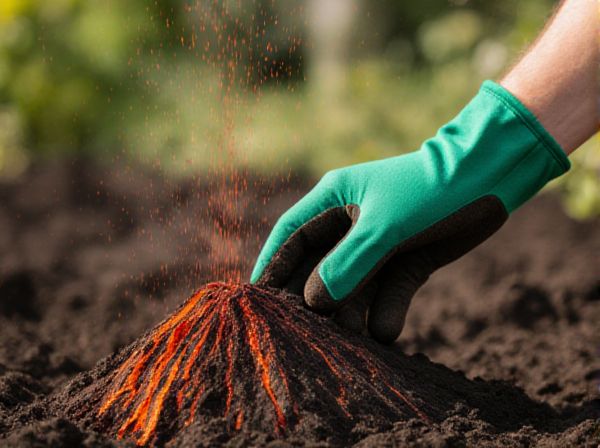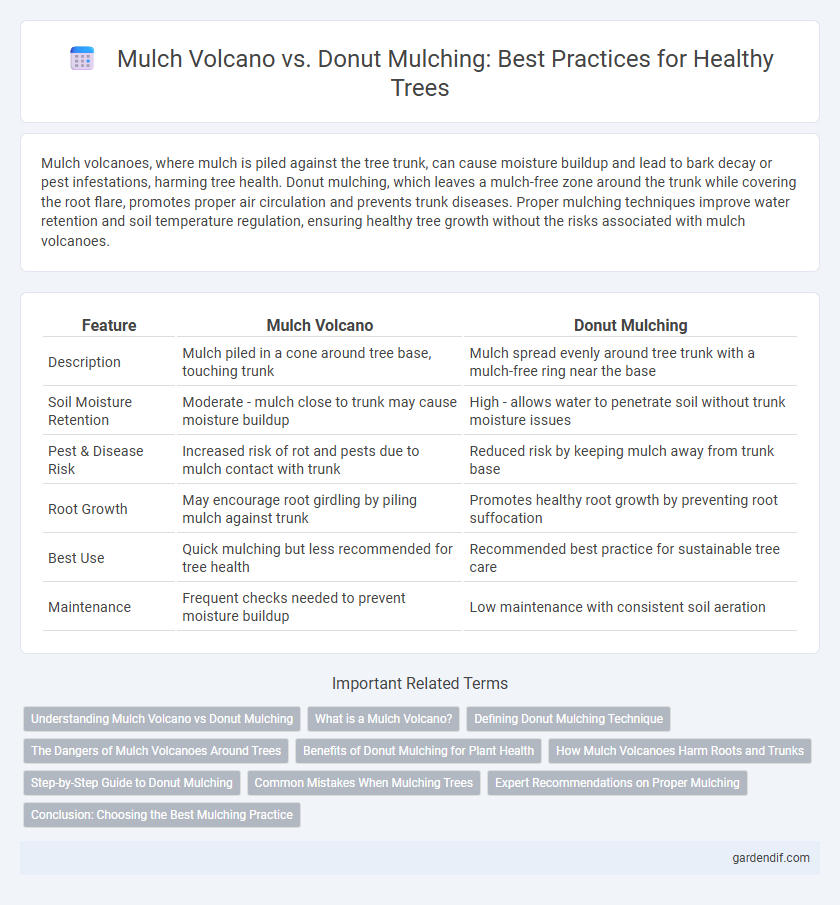
Mulch volcano vs donut mulching Illustration
Mulch volcanoes, where mulch is piled against the tree trunk, can cause moisture buildup and lead to bark decay or pest infestations, harming tree health. Donut mulching, which leaves a mulch-free zone around the trunk while covering the root flare, promotes proper air circulation and prevents trunk diseases. Proper mulching techniques improve water retention and soil temperature regulation, ensuring healthy tree growth without the risks associated with mulch volcanoes.
Table of Comparison
| Feature | Mulch Volcano | Donut Mulching |
|---|---|---|
| Description | Mulch piled in a cone around tree base, touching trunk | Mulch spread evenly around tree trunk with a mulch-free ring near the base |
| Soil Moisture Retention | Moderate - mulch close to trunk may cause moisture buildup | High - allows water to penetrate soil without trunk moisture issues |
| Pest & Disease Risk | Increased risk of rot and pests due to mulch contact with trunk | Reduced risk by keeping mulch away from trunk base |
| Root Growth | May encourage root girdling by piling mulch against trunk | Promotes healthy root growth by preventing root suffocation |
| Best Use | Quick mulching but less recommended for tree health | Recommended best practice for sustainable tree care |
| Maintenance | Frequent checks needed to prevent moisture buildup | Low maintenance with consistent soil aeration |
Understanding Mulch Volcano vs Donut Mulching
Mulch volcanoes occur when mulch is piled tightly around a tree trunk, causing moisture buildup and potential bark rot, while donut mulching involves creating a mulch ring around the tree without touching the trunk, promoting better air circulation and root health. Studies show that donut mulching reduces the risk of pest infestations and fungal diseases compared to mulch volcanoes, which can harbor harmful organisms. Tree care experts recommend maintaining a 2-3 inch mulch layer in a donut shape extending at least 12 inches from the trunk to optimize tree growth and prevent trunk decay.
What is a Mulch Volcano?
A mulch volcano occurs when mulch is piled up against the trunk of a tree, creating a mound that resembles a small volcano. This practice traps moisture against the bark, leading to bark decay, rodent infestations, and increased risk of disease. Unlike donut mulching, which leaves space around the trunk to allow air circulation and prevent damage, mulch volcanoes are detrimental to tree health and should be avoided.
Defining Donut Mulching Technique
Donut mulching involves creating a circular ring of mulch around the base of a tree or plant, leaving the trunk or stem area clear of coverage to prevent moisture buildup and decay. This technique contrasts with traditional volcano mulching, where mulch is piled up against the trunk, often causing root suffocation and pest problems. By using donut mulching, gardeners optimize soil moisture retention and root health while reducing the risk of fungal infections and bark rot.
The Dangers of Mulch Volcanoes Around Trees
Mulch volcanoes, where mulch is piled excessively against tree trunks, create moist conditions that promote bark decay and attract pests, leading to weakened tree health and increased risk of disease. Donut mulching, which keeps mulch spread evenly around the root zone and away from the trunk, enhances moisture retention and soil temperature regulation without suffocating the tree base. Avoiding mulch volcanoes significantly reduces the chances of root rot, trunk girdling, and pest infestations, ensuring long-term tree vitality.
Benefits of Donut Mulching for Plant Health
Donut mulching improves plant health by enhancing root oxygenation and preventing stem rot, as it creates a clear zone around the plant base that avoids moisture buildup. This method reduces pest infestations and fungal diseases by minimizing direct contact between mulch and the plant stem. Improved soil aeration and moisture retention near the roots promote stronger and healthier plant growth compared to traditional volcano mulching.
How Mulch Volcanoes Harm Roots and Trunks
Mulch volcanoes, characterized by large mounds piled against tree trunks, restrict oxygen flow and create moisture buildup that fosters decay and pest infestation in roots and trunks. Donut mulching, which maintains a cleared ring around the trunk while spreading mulch evenly beyond the root zone, prevents these harmful conditions and promotes healthier root respiration and trunk stability. Excessive mulch piled in volcano-like formations can suffocate root systems, impair nutrient uptake, and accelerate bark deterioration, ultimately compromising tree vitality.
Step-by-Step Guide to Donut Mulching
Donut mulching involves creating a circular mulch ring around the base of a tree, leaving a gap around the trunk to prevent moisture buildup and pest infestation, which contrasts with the volcano mulching method that piles mulch against the trunk. Begin by clearing a 2-3 inch thick layer of mulch in a 2-3 feet diameter ring around the tree, ensuring the trunk remains exposed and mulch is spread evenly outward. This technique improves root oxygen access, reduces decay risk, and enhances moisture retention, promoting healthier tree growth compared to volcano mulching.
Common Mistakes When Mulching Trees
Common mistakes when mulching trees include creating volcano-shaped mulch piles that touch the tree trunk, leading to moisture buildup and increased risk of bark rot and pest infestation. Donut mulching, which leaves a gap around the trunk, prevents these issues by allowing proper airflow and reducing moisture accumulation at the base. Proper mulch depth, typically 2-4 inches, is crucial to avoid root suffocation and promote healthy tree growth.
Expert Recommendations on Proper Mulching
Expert recommendations emphasize the importance of applying mulch in a volcano shape to protect tree trunks from moisture buildup and pest infestations, while donut mulching--leaving a gap around the base--is often advised to prevent bark decay and allow proper airflow. Proper mulching depth should range from 2 to 4 inches to retain soil moisture and regulate temperature without suffocating roots. Specialists advocate for organic mulch materials like bark or wood chips, maintaining a mulch ring of 3 feet in diameter around trees for optimal health and growth.
Conclusion: Choosing the Best Mulching Practice
Volcano mulching, characterized by a conical mulch pile around trees, often leads to moisture retention issues and bark decay, whereas donut mulching, which leaves a bare zone near the trunk, promotes better aeration and root health. Research indicates donut mulching reduces pest infestation and enhances soil microbial activity compared to volcano mulching. Selecting donut mulching aligns with best practices for sustainable plant growth and long-term tree health.
Mulch volcano vs donut mulching Infographic

 gardendif.com
gardendif.com